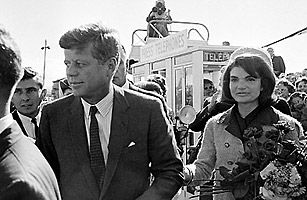
The president and his wife in Dallas.
Nov. 22, 1963
The backseat of President John F. Kennedy's limousine was a leather pit of horror, flecked with bits of flesh and a crust of drying blood that a grim young Secret Service agent was trying to wipe up with a sponge. He seemed hesitant, cowed by the task. On the front seat of the Lincoln lay the crushed red roses that Jackie Kennedy had been carrying. It was a certain and brutal end to a great national drama, but none of the people milling around on the driveway of Parkland Hospital that day wanted to allow the curtain to fall. Yet we knew it had.
I recall staring down into that miserable, tiny abattoir and shuddering and trying to understand that in a few seconds on a gloriously sunny day in an otherwise happy time, a friend had been murdered; a President assassinated; a political movement, which we called the New Frontier, terminated. We reporters had been riding casually in the press buses when we heard three sharp, strange sounds from an ugly building 50 yards in front of us. CBS correspondent Robert Pierpoint, who had covered the Korean War, leaped to his feet and said, "Those sounded like gunshots." In a few seconds we saw the chaos on the grassy knoll, people facedown clutching the earth in panic, the motorcade chopped in two, Kennedy's limousine racing over a hill toward the hospital.
The monstrous event was confirmed at Parkland Hospital in small, prosaic episodes. Two priests arrived to give last rites, and coming out of the hospital, one of them blurted, "He's dead, all right." That was the first bulletin of death in a tragedy that was seizing the world, and for four more days would grow and be embedded in history by television saturation the likes of which we had never seen before.
Assistant press secretary Malcolm Kilduff took the podium in a stark hospital classroom and, reading off a scrap of paper that fluttered with his hand, announced, "President John F. Kennedy died at approximately 1 o'clock Central Standard Time today, here in Dallas." I remember wondering how anything as exuberant as the Kennedy Administration could end in such a simple sentence. Around the corner in his makeshift office, Kilduff sat mute, weeping. "Can you tell me anything more?" I asked as gently as I knew how. He tossed the announcement paper at me, then he whispered, "Oh, that man's head. Oh, his head."
Jackie Kennedy rested her hand on the casket as it was wheeled down the loading ramp of the hospital. For the first time we saw the bloodstains on her pink suit. She climbed into a white hearse with the lifeless body of her husband, while on the parking apron, the mortician argued with the Secret Service about payment for the casket and the car.
Lyndon Johnson took the presidential oath in the cramped fuselage of Air Force One, surrounded by Jackie, Lady Bird, aides from both staffs and a handful of reporters, leaning and pushing against one another to witness this historic moment. Soon afterward one of them, Sid Davis, the White House reporter for Westinghouse Broadcasting, climbed on the trunk of a car at the edge of Love Field and was relating the story of that frantic, improvised Inauguration. He had to pause as Air Force One roared down the runway and took off, heading back to Washington — the most devastating and yet the most historic flight that grand airplane had ever taken.